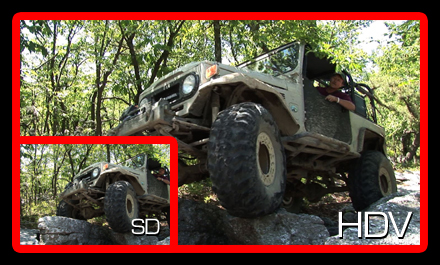High definition offers about 4 times the resolution of standard definition images and has a different shaped native resolution. The standard definition TV/monitor displays about 720 pixels across the screen and about 480 pixels top to bottom. The shape of the SD screen has a 4:3 aspect ratio. That means even though the size of the monitor could change the image will still be 4 units across compared to 3 units high. This has been an established format for decades and producing a SD final production means that right now it will play back on many more screens. Typically the video will be provided on a DVD-Video disk in SD which will allow playback on a DVD drive equipped computer with DVD playback software or on a desktop DVD player connected to a monitor or TV set.
Current standards for high definition images are mixed but a "full" HD video stream is 1920 pixels across and 1080 pixels high. The shape of a full HD screen has a 16:9 aspect ratio, meaning 16 units across and 9 units high. HD monitors today may have up to that full HD pixel resolution or be something less like 1320x720. The shape of the screen is still the same. C to C shoots in a HD format called HDV. Our cameras shoot in HD and we transfer the images in HD to a hard drive in a computer for editing and the final production is usually exported to an HD tape for mastering. C to C can create a HD-DVD disk in house that will maintain the very high image quality, but you would need an HD capable DVD player connected to a HD monitor to see it. Right now HD productions we create tend to be down converted to SD so they can play back on most of the worlds DVD players. We can preserve the aspect ratio by creating a final production that is letter boxed so you would see black bars on the top and bottom of the screen. Technology is always changing and as HD players and monitors drop in price and increase in capabilities it may mean shooting and or editing your production in HD is planning for the future. A television commercial if it is to be broadcast in HD could be provided on a HDCAM 1920x1080 broadcast tape preserving the full resolution. At present most HD broadcasters are using lower HD resolutions to transmit their signals. Is there a cost difference? Yes. The HD cameras are the latest technology, and editing requires more space, faster processors and graphics processing and requires longer render times. Does the image quality look incredibly better in HD? Yes. C to C can advise you as to what way to go given your final production needs.
|
